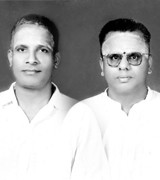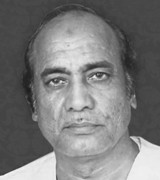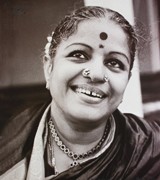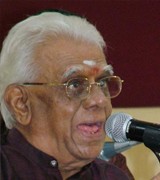COVER STORY
ALATHUR BROTHERS - By music conjoined
T.T. NARENDRAN

The finest singing duo of the 20th century, in the field of Carnatic music, was the Alathur Brothers – formally Srinivasa Iyer and Sivasubramania Iyer, and informally Cheenu and Subbu. In this centenary year of the more popular but the younger of the two, Alathur Sivasubramania Iyer, much has been written, said and telecast about the duo, revealing that they were musical brothers hailing from two different families from different linguistic backgrounds.
The story begins with Alathur Venkatesa Iyer, their guru. Venkatesa Iyer learnt music from Dasavadyam Krishna Iyer of Tiruvaiyaru. Krishna Iyer, according to some accounts, was a disciple of Tillaisthanam Panju Bhagavatar, a direct disciple of Tyagaraja. Another version says that Venkatesa Iyer was a disciple of Manambuchavadi Venkatasubba Iyer. Either way, the line traces back to the saint-composer.
SPECIAL FEATURE
REMEMBERING MEHDI HASSAN - The Shahansha-e-Ghazal
MANOHAR PARNERKAR

13 June 2016 marks the fourth barsi or death anniversary of Mehdi Hassan (Khansaheb). Readers may recall that on his third death anniversary, a fairly comprehensive article entitled Remembering Mehdi Hassan – The Shahansha-e-Ghazal, was publishedin the June 2015 issue of Sruti. Its main theme was how Mehdi Hassan single-handedly, and radically, transformed the traditional sung ghazal form, and how, in the process, he became its Shahansha. This second and concluding article – generally anecdotal in nature, and somewhat lighter in tone – would centre around and flesh out at least three important facets of Khansaheb’s life and art that were highlighted in the first article. One, his strong Indian roots – ancestral, cultural and musical. Two, his professional as well as deep personal associations with the land of his birth; these seem to have begun, in a big way, in the mid-1970s, and lasted up until 2002 or so, when he became too ill to travel and perform. And three, his phenomenal popularity with the ruling politico-cultural elite, the cognoscenti as well as the lay listener in India, Afghanistan and Nepal – three of Pakistan’s neighbours
THE MS CENTURY
MS and Tamil Isai
GOWRI RAMNARAYAN

Tributes are being paid everywhere to the legendary Carnatic musician M.S. Subbulakshmi by innumerable organisations holding innumerable concerts with innumerable musicians old and young. So, though I was grateful to the Sruti Foundation for giving me an opportunity to celebrate her 100th year, I wondered how and what I could add to the homage. What can I say about MS that has not been said?
I remembered Subbulakshmi’s crusade for Tamil Isai, a less known, near forgotten chapter in her life.
We have all seen MS as the upholder of tradition, as a meek, unassuming, modest, super-conservative Indian woman of the old school. How interesting then to see MS in the role of a rebel! In the 1930s and 1940s, M.S. Subbulakshmi found herself in the midst of an aggressive, no-holds-barred, brangling controversy. Mind you,not on the side of Authority and Status Quo, but on theother side of the fence!
INTERVIEW
S.R. JANAKIRAMAN
S.R. JANAKIRAMAN IN CONVERSATION WITH V. RAMNARAYAN AND NAVANEET KRISHNAN

Prof. S.R. JANAKIRAMAN turns 88 on 12 July this year. When Sruti called on the veteran musicologist to congratulate him on his being conferred the Sangeet Natak Akademi Fellowship he spoke at length on what Carnatic music means to him. His originality of musical thought, his passion for his art and his reverence for his gurus make him an electrifying conversationalist. Some excerpts:
How important has the recognition been to you as a musician?
While there have been 86 Sangita Kalanidhis, only ten or 15 musicians and scholars from south India have received the honour of the SNA Fellowship. They include greats like Ariyakudi Ramanuja Iyengar, Musiri Subramania Iyer, Semmangudi Srinivasa Iyer, Prof. P. Sambamoorthy, Embar Vijayaraghava-chariar, M.S. Subbulakshmi, M.L. Vasanthakumari, Dr. V. Raghavan, Umayalpuram K. Sivaraman, T.H. Vinayakram, Lalgudi G. Jayaraman, Dr. Padma Subrahmanyam and some others. I have now been clubbed with truly great legends – and that is the greatest honour for me.


